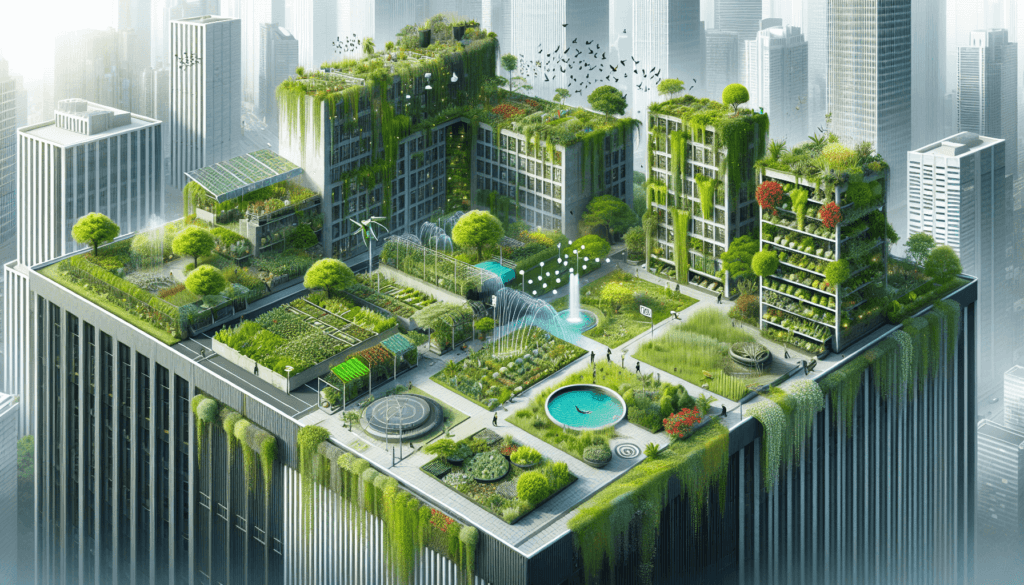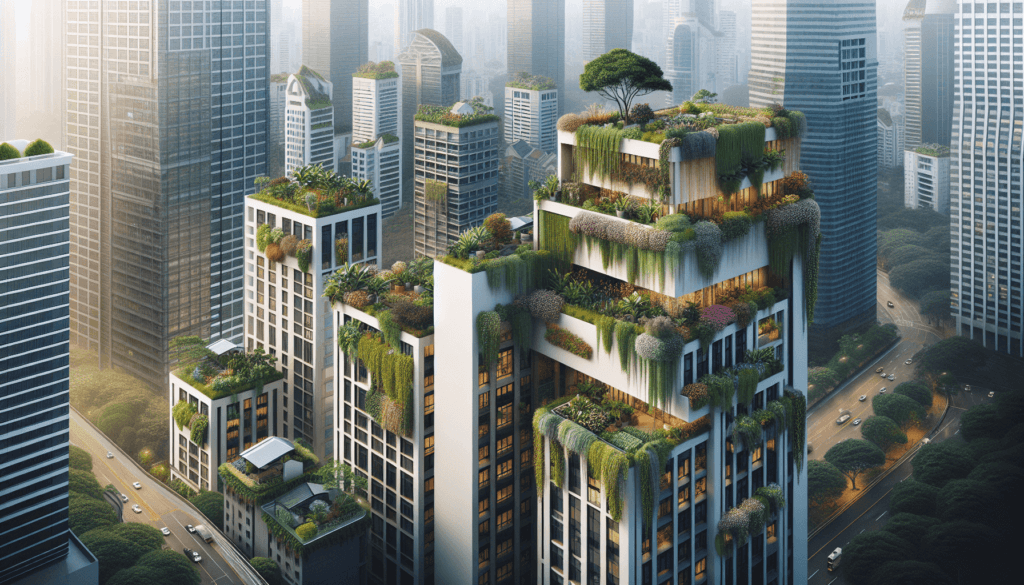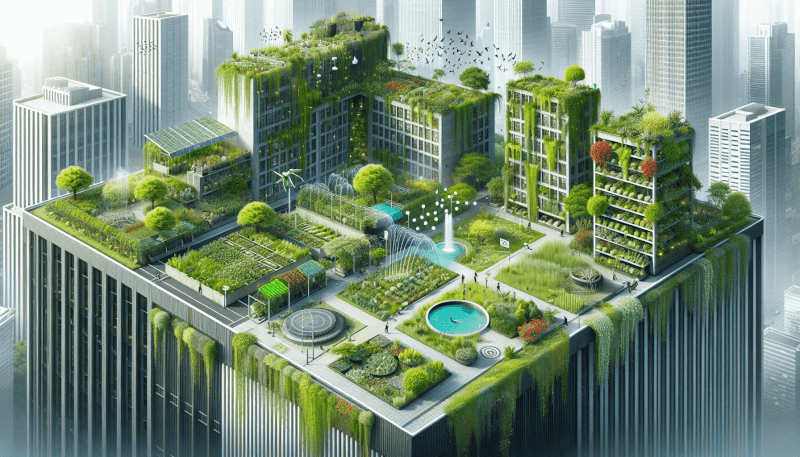Imagine yourself stepping into an oasis high above the bustling city streets, where lush greenery and vibrant blooms transport you to a serene escape. This is precisely what awaits you at The Garden Rooftop, a hidden gem nestled among the skyscrapers. With its harmonious blend of nature and urban living, this rooftop paradise is the perfect retreat for those seeking solace and tranquility amidst the chaos of everyday life. Prepare to be enchanted as you embark on a journey through this verdant wonderland, where fresh air, breathtaking views, and the soothing sounds of nature are your constant companions.

Benefits of a Garden Rooftop
Beautifies the Space
A garden rooftop provides a stunning visual appeal to any space it occupies. The vibrant colors and lush greenery create a calming and serene atmosphere. Whether you’re in a residential or commercial setting, a garden rooftop instantly transforms a plain and conventional roof into a vibrant and aesthetically pleasing space. Imagine relaxing on a rooftop surrounded by blooming flowers, cascading vines, and the soothing sound of chirping birds. It’s a truly picturesque and refreshing experience that elevates the overall ambiance of the space.
Reduces Energy Consumption
One of the remarkable benefits of having a garden rooftop is its ability to reduce energy consumption. The layer of soil and vegetation acts as a natural insulator, providing additional thermal protection to the building underneath. This insulation helps regulate the temperature inside the building, keeping it cooler during hot summer months and warmer during cold winter months. By minimizing the fluctuations in temperature, a garden rooftop significantly reduces the need for artificial heating and cooling systems, leading to lower energy consumption and reduced utility bills.
Improves Air Quality
In an urban environment, air pollution is a prevalent concern. However, a garden rooftop plays a vital role in improving air quality. Plants naturally absorb carbon dioxide and release oxygen through photosynthesis, helping to filter and purify the air. By having a garden rooftop, you contribute to reducing the overall carbon footprint and creating a healthier environment. Additionally, the dense vegetation helps trap dust particles and pollutants, preventing them from circulating in the air. This improved air quality has beneficial impacts on both physical health and mental well-being.
Provides Food Security
With increasing concerns about food security and sustainability, having a garden rooftop offers a practical solution. By growing your own fruits, vegetables, and herbs, you can ensure a constant supply of fresh and organic produce right at your doorstep. Rooftop gardens are ideal for cultivating high-yield crops that require less space and can thrive in urban environments. Additionally, having access to homegrown food promotes a healthier lifestyle and reduces reliance on commercially produced food, which may contain harmful chemicals and pesticides.
Choosing the Right Plants
Climate Considerations
When selecting plants for your garden rooftop, it’s crucial to consider the climate of your region. Different plants have varying temperature and sunlight requirements, so it’s essential to choose species that can adapt well to your specific climate conditions. Research which plants are suitable for your area and select ones that are resilient to extreme temperatures, strong winds, and other environmental factors.
Planting Containers
Since rooftop gardens are usually limited in space, it’s important to maximize the use of planting containers. Choose containers that are lightweight, durable, and have sufficient drainage holes to prevent waterlogging. Opt for containers made from materials such as recycled plastic, fiberglass, or terracotta. Additionally, consider using raised beds or hanging baskets to utilize vertical space effectively.
Suitable Plant Varieties
Certain plants perform better in rooftop environments due to their ability to withstand the unique challenges presented by the elevated position. Look for plant varieties that have shallow root systems, are drought-tolerant, and can handle the exposure to sunlight and wind. Succulents, dwarf fruit trees, herbs, and ornamental grasses are excellent choices for rooftop gardens.
Maintenance Requirements
Consider the feasibility of maintaining your chosen plants before incorporating them into your garden rooftop. Ensure that you can provide the necessary care, such as regular watering, pruning, and fertilizing. Choose plants that fit into your available time and resources, so you can enjoy your rooftop garden without it becoming a burden.
Structural Considerations
Weight Considerations
Before implementing a garden rooftop, it’s crucial to assess the weight-bearing capacity of your roof. The soil, containers, plants, and other structures add significant weight, which may exceed the roof’s load-bearing limit if not properly evaluated. Consult with a structural engineer or an experienced contractor to determine if any reinforcements are necessary to support the garden.
Waterproofing
Proper waterproofing is essential to prevent any water leakage or damage to the structure of the building. Install a waterproof membrane on the rooftop before adding any soil or containers. This protective layer ensures that excess water does not seep into the building and protects it from potential water damage. It is advisable to consult a professional to ensure the waterproofing is done correctly.
Drainage System
An efficient drainage system is crucial to prevent water accumulation and potential structural damage. Install a reliable drainage system that directs excess water away from the rooftop, preventing any pooling or flooding. Incorporating drainage layers, such as gravel or drainage mats, beneath the soil can help improve water flow and prevent waterlogging.
Access Points
Consider the accessibility of your garden rooftop when planning its design. Ensure that there are safe and convenient access points for maintenance, watering, and harvest. Installing staircases, ladders, or even an elevator can make reaching the rooftop easier and more enjoyable.
Preparing the Rooftop
Assessing the Roof Condition
Before starting your garden rooftop project, it’s essential to assess the condition of your roof. Check for any signs of damage, leaks, or structural issues. Fix any existing problems before proceeding with the garden installation to prevent further damage or complications.
Checking for Structural Integrity
A garden rooftop adds additional load to your roof, so ensuring its structural integrity is vital for safety. Inspect the roof thoroughly for any signs of weakness or deterioration. Look out for sagging, cracks, or any other indicators that the roof may not be able to support the added weight. If you notice any concerns, consult a professional to assess the roof’s strength and stability.
Removing Debris
Clear the rooftop of any debris, such as leaves, branches, or trash, before setting up your garden. Ensure that the surface is clean, level, and free from any obstructions. This not only improves the aesthetic appeal but also prevents potential damage to the plants and the roof.
Ensuring Proper Sealing
To avoid any water leakage or damage, ensure that all penetrations and gaps on the roof are properly sealed. Check for cracks or gaps around vents, chimneys, and any other openings. Apply sealants or flashing as necessary to create a watertight barrier and protect the underlying structure from moisture.

Irrigation and Watering Methods
Drip Irrigation Systems
Consider installing a drip irrigation system for efficient and controlled watering of your rooftop garden. Drip irrigation delivers water directly to the plant’s roots, minimizing water wastage through evaporation or runoff. It also promotes deeper root growth and helps prevent water-related diseases in the plants.
Self-watering Containers
If you have limited access to water or find it challenging to water your plants regularly, self-watering containers can be a great solution. These containers have built-in reservoirs that store water, which slowly releases to provide consistent moisture to the plants. Self-watering containers are especially beneficial in hot and dry climates.
Rainwater Harvesting
Make use of rainwater by installing rain barrels or a rainwater harvesting system. Collecting rainwater not only reduces your water consumption but also provides plants with a natural and beneficial water source. Use the collected rainwater to supplement your regular watering routine, especially during periods of drought or water restrictions.
Monitoring and Adjusting Watering Needs
Regularly monitor the moisture levels of your garden rooftop to ensure that your plants receive adequate hydration. Use a moisture meter or simply check the soil’s dampness with your finger. Adjust your watering schedule accordingly, considering factors such as weather conditions and plant requirements. Overwatering can lead to root rot, while under watering can cause wilting and stunted growth.
Choosing the Right Soil and Compost
Balancing Drainage and Retention
When selecting soil for your garden rooftop, strike a balance between drainage and water retention. Use a lightweight soil mix specifically designed for container gardening. This type of soil is porous enough to promote drainage, preventing waterlogging, yet absorbs and retains enough moisture to keep the plants hydrated.
Types of Compost
Incorporating compost into your rooftop garden is essential for plant nutrition and soil health. Use organic compost made from kitchen scraps, yard waste, or purchase commercially available compost. Compost adds vital nutrients to the soil, improves its structure, and enhances microbial activity, creating a thriving environment for plants.
Mixing Soil and Compost
Create a suitable growing medium by mixing the soil and compost in the right proportions. A well-balanced mix ensures that plants receive the necessary nutrients while maintaining proper drainage. Aim for a soil composition that is around 50% soil and 50% compost, adjusting based on specific plant requirements.
Fertilizer Considerations
Supplement the soil’s fertility by periodically applying organic fertilizers. Organic fertilizers provide essential nutrients to the plants in a slow-release form, promoting healthy growth and preventing nutrient deficiencies. Use fertilizers that are specifically formulated for container gardening to ensure optimum plant health.
Attracting Beneficial Wildlife
Planting Native Flowers
Attract beneficial wildlife such as butterflies and bees by incorporating native flowers into your garden rooftop. Native flowers provide a valuable source of nectar for pollinators and create a beautiful display of colors. Research the native flower species in your region and choose ones that are well-suited to the rooftop environment.
Installing Bird Feeders
Invite birds to your garden rooftop by installing bird feeders. Choose feeders that are suitable for the bird species found in your area and provide a variety of seeds, suet, or nectar. Feeding birds not only adds life and movement to your rooftop garden but also helps control pests naturally.
Providing a Water Source
To attract birds and other wildlife, ensure there’s a freshwater source available. Install a bird bath or small shallow containers filled with water to provide birds with a place to drink and bathe. Be mindful of regularly cleaning and changing the water to prevent mosquito breeding.
Creating Insect Habitats
Encourage beneficial insects, such as ladybugs and bees, by incorporating insect habitats into your garden rooftop. Create small nooks and crannies using materials like hollow bamboo poles or drilled wooden blocks. These spaces provide shelter and nesting sites for beneficial insects that help control pests and promote pollination.
Creating a Functional and Aesthetic Design
Zoning the Space
Divide your garden rooftop into different zones based on functionality and plant types. Consider areas for relaxation, dining, gardening, or simply enjoying the view. Zoning helps create a well-organized and visually appealing garden, making it easier to navigate and maintain.
Integrating Pathways and Seating
Incorporate pathways and seating areas into your rooftop garden design to enhance accessibility and usability. Use materials such as weather-resistant wood, stone, or recycled materials to create pathways that connect different areas of the garden. Include comfortable seating options where you can relax and enjoy the surroundings.
Adding Decorative Elements
Enhance the aesthetics of your garden rooftop by adding decorative elements. Install trellises or support structures for climbing plants, hang decorative wind chimes, or place colorful planters strategically throughout the space. These elements add visual interest and contribute to a personalized and inviting rooftop garden.
Installing Lighting
Extend the usability of your garden rooftop into the evening by installing appropriate lighting. Use string lights, solar-powered lanterns, or strategically placed spotlights to create a warm and inviting ambiance. Lighting not only adds to the aesthetics but also provides safety and security.
Plant Care and Maintenance
Pruning and Deadheading
Regular pruning and deadheading are vital for maintaining the health and appearance of your plants. Prune any damaged or diseased branches to promote healthy growth and remove spent flowers to encourage new blooms. This practice helps shape the plants and prevents overcrowding.
Pest and Disease Control
Monitor your rooftop garden regularly for signs of pests or diseases and take prompt action to control them. Employ organic pest control methods such as handpicking pests, using insecticidal soap, or introducing beneficial insects. Regularly inspect your plants for any signs of disease, and if necessary, apply appropriate organic fungicides or seek guidance from gardening professionals.
Weed Management
Prevent weed growth by regularly inspecting your rooftop garden and promptly removing any weeds that appear. Manual removal is often the most effective and environmentally friendly method. Mulching around your plants with organic matter can also help suppress weed growth and retain soil moisture.
Fertilization and Nutrient Supplementation
Maintain proper plant nutrition by fertilizing your rooftop garden as needed. Organic fertilizers can be applied periodically to replenish essential nutrients and support healthy growth. Follow the manufacturer’s instructions for application rates and frequency to ensure optimum plant health.
Harvesting and Utilizing the Garden
Harvesting Fresh Produce
Enjoy the fruits (and vegetables) of your labor by harvesting fresh produce from your garden rooftop. Monitor your plants for ripeness and harvest them at the peak of their flavor and quality. Regular and timely harvesting encourages continued production and ensures the best taste and nutritional value.
Culinary Uses of Herbs and Vegetables
Explore the culinary world by utilizing the herbs and vegetables grown in your garden. Experiment with different recipes, flavors, and cuisines to enhance and elevate your dining experiences. Freshly harvested herbs and vegetables add an extra dimension of taste and aroma to your culinary creations.
Preservation and Storage
If you have bountiful harvests or wish to enjoy your rooftop-grown produce all year round, consider preservation and storage methods. Can your fruits and vegetables, make homemade jams and preserves, or freeze them for later use. Drying herbs is also a popular and easy way to preserve their flavors.
Sharing with Others
Spread the joy of gardening by sharing your rooftop-grown bounty with friends, family, or your local community. Share surplus produce, herbs, or flowers to ensure that everyone gets to taste the benefits of your garden rooftop. You can also donate excess harvest to food banks or participate in community share programs.
By embarking on the journey of creating a garden rooftop, you not only beautify your space but also reap numerous benefits for yourself and the environment. From reducing energy consumption to improving air quality and fostering food security, the advantages are vast. With proper planning, suitable plant selection, and diligent maintenance, your garden rooftop can flourish into a serene and productive haven. So seize the opportunity to transform your rooftop into a vibrant and sustainable oasis, and enjoy the many rewards it brings. Happy gardening!


